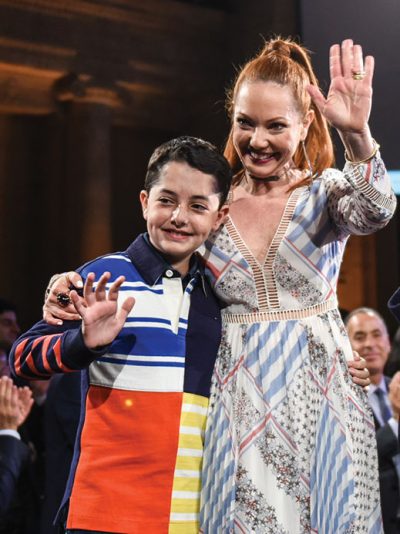
Mindy Scheier’s son wanted to wear jeans to school, commonplace for most kids but impractical for Oliver, then 8, who had been stricken with muscular dystrophy and couldn’t fit slim pants over his leg braces.
Scheier didn’t want to say no to her son. Armed with scissors and two decades of fashion-industry experience, she worked at her kitchen table of her Livingston home, cutting apart a pair of jeans. Using rubber bands and Velcro strips, Scheier crafted custom pants for Oliver.
“The next day, he was so excited and dressed himself. It was such a powerful moment,” says Scheier, 47. She and husband Greg are also parents to Stella, 16, and Beau, 9. “If Oliver was experiencing this, I couldn’t imagine what other people with disabilities experienced.”
Scheier searched online for clothing for people with disabilities and found only plain, baggy options. Detecting a huge gap in the apparel industry, she launched the Runway of Dreams Foundation, with a mission to bring fashionable adaptive clothing—clothing modified for disabled people—into the mainstream.
After a year of research, Scheier began to make prototypes of adaptive fashions, replacing buttons, snaps and zippers with Velcro closures and magnets. She sewed in a button system for self-hemming for people with different sized limbs. For those in wheelchairs or with muscle-tone issues, she designed openings in the back of shirts and on pant legs. All the while, she maintained the stylish look of each garment.
Next, she partnered with Tommy Hilfiger, which in 2016 unveiled the first adaptive collection for children from a global fashion brand. Hilfiger now produces new kids’ and adult collections each season, and companies like Nike, Target, Lands End and Zappos also have created their first adaptive lines. “We want designers and brands to look at adaptive clothing as just a different fit,” says Scheier.
That’s great for kids like Gianna Schiavone, 9, of East Hanover. Schiavone was born missing her left forearm and hand. Her go-to pieces include a Tommy Adaptive faded denim jacket and pink plaid button-down shirt, which she can put on by herself thanks to magnets sewn inside. “It’s a big confidence booster for her,” says her mother, Mary Grace Schiavone.
“It’s so unbelievable to me that something I did on my kitchen table is now helping millions of people,” says Scheier.
